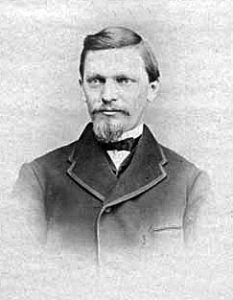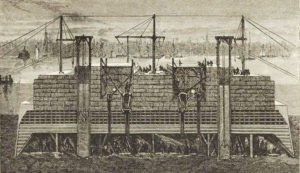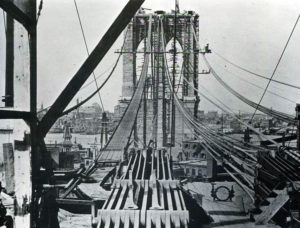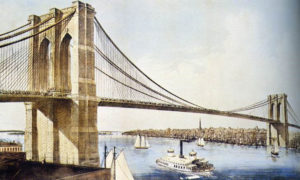Washington A. Roebling assisted his father in the design of the bridge from March 1868, after he returned from his combination honeymoon and fact-finding trip to Europe. While in Europe, he visited Telford’s Menai Straits suspension bridge, Brunel’s Clifton suspension bridge, and many others. Washington toured the steel mills of England and Germany and learned all he could about pneumatic caissons. He wrote lengthy letters to his father about his trip, containing information that would be helpful in the bridge design. He spent most of the summer working on plans and the equipment necessary to place the huge pneumatic caissons for the Brooklyn and Manhattan Piers. Based on borings, rock was 106 feet deep on the Manhattan side and 98 feet on the Brooklyn side. No one had ever reached those depths with pneumatic caissons – even though James Eads was about to in St. Louis – as the pressure of 50 psi and greater made it necessary to keep the water out. By the end of 1868, the father and son team had worked out tentative plans for the caissons. As mentioned in Part 1 (STRUCTURE, August 2016), the team of consulting engineers in the spring of 1869 made their tour of Roebling’s other suspension bridges at Niagara, Pittsburg, and Cincinnati, and submitted a favorable report.
John A. Roebling suffered his accident near the Fulton Ferry on June 28, 1869, and died on July 22nd, less than a month later. At this time, very few detailed plans for the bridge and caissons had been prepared other than preliminary plans submitted with John’s 1867 report. He had indicated to William Kingsley and others that Washington was more than qualified to take over for him. In early August, the Board appointed Washington Roebling Chief Engineer with the support of the Brooklyn Eagle, one of the main supporters of the bridge. He was only 32 years old and found himself in charge of the longest suspension bridge in the world.
The first thing Washington did was recruit a team of associates to assist him in the design and construction of the bridge. His father had used two young German engineers in 1867 to help him in the design. Washington, however, went to his alma mater, Rensselaer Polytechnic Institute, and hired Francis Collingwood (class of 1855) and C. C. Martin (class of 1856). He added Wilhelm Hildenbrand, who had assisted his father in 1867, and Col. William Paine, whom he may have met during the Civil War. Sam Probasco and George McNulty completed the seven-man team. These men would stay on the project for the next 14 years.
The first task was to prepare the final design for the Brooklyn caisson. Roebling knew that this was the most difficult part of the project given the depth to a firm foundation. To support the huge masonry towers and twin Gothic arch passageways his father had designed, a caisson 168 feet by 102 feet was required. He put Collingwood, Hildenbrand, and Paine to work on the design. A contract was awarded to Webb & Bell, a local shipbuilder, on October 25, 1869, to build the caisson in a nearby shipyard and launch it like a ship when completed. The caisson had two dredging (water shafts) wells, two supply shafts, and two airlocks for worker’s access. The pressurized chamber was 9½ feet high and had 5 layers of timbers for a roof and tapered walls with an iron cutting edge at their base. The outside was covered with sheet metal. Also, he had five cross walls included supporting the roof during the launch and the placing of the masonry. The 6,000,000-pound caisson was launched on March 19, 1870. It was the heaviest structure ever launched in the United States at the time. His father’s early plans had a much thicker roof that Washington changed when he became Chief Engineer. It was towed into a prepared enclosure and positioned on May 3rd. He then added 10 more tiers of timber to the top of the caisson, making it 15 feet thick.
As masonry was added to the top of the caisson, it sank into the softer surface soils. When it was sealed all around, compressed air was pumped into the chamber, expelling the water. Men then accessed the chamber through the air locks and started digging out under the cutting edges and cross walls. They loaded the dirt into wheelbarrows and dumped it under the water shafts, where it would be removed by clamshell buckets, lifted through a column of water, and dumped into scows. Progress was slowed when a fire broke out, burning many timbers in the roof. At a depth of 44½ feet below the river surface, Roebling determined the dense, rocky soil was firm enough to rest his tower on. The chamber was filled with concrete and brick piers and was completed in March 1871.
The New York Caisson was a little larger, 172 feet by 102 feet, and weighed 3,250 tons. Its timber roof was also 12 feet thick. Like the Brooklyn caisson, additional timbers, 10 layers, were added due to the extra weight of masonry planned to be placed on it when it was floated into position. It was launched and moved into position in October 1871. To guard against fire, Roebling lined the caisson with sheet iron. The soil was mainly sand, and he used a sand pump, similar to that employed by James Eads at his St. Louis Bridge, as well as a piping system that allowed the compressed air in the caisson to eject sand to the surface. Roebling had visited Eads to observe his pneumatic caissons and his use of sand pumps.
As he went deeper, past 45 feet, men started suffering from what became known as caisson disease, the Bends, with some fatal attacks (estimated at five deaths). Eads, at St. Louis, determined he had to regulate the number of hours men worked under pressure and how long they should decompress before exiting the air locks. Roebling believed it was a matter of how long men worked under pressure and cut the workday to 4 hours under pressure, 2 hours out of the caisson, and another four hours under pressure. He later reduced the shift time to 5 hours. His doctor on staff prepared a list of precautions the men should take and eventually increased the time it would take to decompress in the air locks. Despite this, his men continued to suffer. On May 18, 1872, at a depth of 78 feet 6 inches, Roebling decided the dense sand and gravel would support his tower.
The chamber was filled with only concrete this time. While it was being placed, Roebling suffered another case of the “bends,” and many thought he might die. He recovered but had recurring bouts of pain. The caisson was filled with concrete on July 12, 1872. Roebling started missing many days at work due to the lingering effects of the disease.
Masonry continued to be added to both towers. By late November, work stopped on the Brooklyn Tower at an elevation of 145 feet, well above the deck level. The Company had widened the bridge to 85 feet, Roebling had modified his father’s plan, and now the three legs of the tower were taking shape. In late December, work stopped on the New York Tower at a height of 60 feet. Roebling’s health deteriorated rapidly. During the winter, when able, he wrote detailed instructions for his assistants to follow when work began again in the Spring.
Roebling asked for a leave of absence in the Spring of 1873 and took a trip to Germany with his wife. In his absence, work on the towers continued. The Brooklyn Tower was completed in June 1875 and the New York Tower in July 1876. They were the second tallest structures in New York at the time.
Work on the anchorages started in February 1873, with McNulty in charge of the Brooklyn anchorage. It was completed in 1875. The New York anchorage began in May 1875 and was completed by Collingwood in July 1876. They were massive structures, 119 feet by 129 feet at the base and 104 feet by 117 feet at the top, and were temporarily stopped at a height of 80 feet. Each weighed 60,000 tons. Massive anchor castings were built with a double row of chain with 3-inch by 7-inch wrought iron eyebars near the anchor casting, increasing to 3- by 9-inch approximately. In the end, there were 38 links for each cable to pick up the 19 strands in the cable.
Roebling returned from Germany in early 1874. His doctors told him to stay away from the bridge, so he and Emily lived in Trenton for the next two years. Washington kept in touch with his assistant engineers, providing detailed written instructions on how to place the masonry in the arches of the towers and anchorages. While the masonry was finished, he began planning for the spinning of the massive cables. Aiding him in this effort was his Master Mechanic, E. F. Farrington, who had worked with him on spinning the cables for the Covington and Cincinnati Bridge.
He completed the specifications for the cables in 1876. They would be 15½ inches (later 15¾ inches) in diameter, consisting of 5,282 wires about 1/8-inch in diameter (Number 7 Birmingham) and for the first time would be steel. He would spin the cables in 19 strands of 278 wires each, and pack them so they could be squeezed into a cylinder that would be wrapped with iron wires. The wires were to be “superior quality steel” and galvanized. He needed 3,400 tons of material with a tensile strength of 160,000 psi. Farrington set up the spinning equipment. On August 14, 1876, the first two cables were carried across the river and connected to form a continuous loop mounted on drive wheels. Farrington, on a boatswain’s chair, went across the river on August 25. The Board, on a motion by Abram Hewitt, voted that no one associated with the Bridge Company would be allowed to bid on the wire contract, including John Roebling’s Sons wire factory nor his company. Roebling threatened to resign over what he considered to be a direct slam on his integrity but was convinced to carry on. He sold his stock in the Company, so John Roebling’s Sons could bid on the wire. He did write a letter to Hewitt stating, “If you receive a bid from a Mr. Haigh of South Brooklyn, it will be well for you to investigate a little.”
In October 1876, Roebling returned to Brooklyn from Trenton by boat and saw the bridge for the first time in three years. He stayed with his brother-in-law, General G. K. Warren, for a while before moving back to Brooklyn Heights. As his health was still poor, he communicated with his assistant engineers through detailed written instructions frequently picked up at the apartment, but sometimes carried to them by his wife Emily, who also wrote some of them from dictated notes by Roebling.
On December 4, 1876, nine bids were received. One of John Roebling’s Sons bids was for Bessemer steel, and it was the lowest submitted, but their other bid, for crucible steel, was higher than J. Lloyd Haigh’s. The Board was ready to award the contract to Roebling for Bessemer steel but many, including the Editor of the Brooklyn Eagle, claimed that just because it was cheaper, it should not be used in a bridge of this size and importance. In late December, the Board yielded and awarded the contract to Haigh for crucible steel.
Roebling, not trusting Haigh, instructed his men to check every “ring” of wire at Haigh’s factory before delivery. By June 1878, he determined that Haigh unsuccessfully attempted to bribe the inspectors and that he had been delivering previously rejected wire to the bridge as having passed inspection. What Haigh did was to replace accepted wire with rejected wire overnight and then delivered it as good wire, after which he submitted the previously accepted wire for testing. At other times, the wagons carrying good wire were rerouted to another location where the good wire was replaced with the rejected wire. It and the acceptance paperwork were taken to the bridge. The inspectors noticed the rejected pile of wire never grew. Roebling and his men found out about this fraud and notified Murphy on July 29.
Murphy and the Board, who had selected Haigh over Roebling, chose not to make this fraud public nor to switch suppliers as Roebling suggested. Roebling estimated that as much as 221 tons of rejected wire had been spun into the cables, which would leave a safety factor of five in the cables. He did, however, add 150 wires to each cable as an additional safety factor and required Haigh to supply them free of charge. Cable spinning of the four big cables began on June 11, 1877, and was completed on October 5, 1878. Washington made sure that the point where the wire cables linked to the anchor chain was open to the air and visible. John had, erroneously it turned out, always covered this connection with concrete, thinking it would protect the wires.
With the cables complete and wrapped, the next step was to install the hangers, deck trusses, and stay cables. The process was the same as Washington used at Cincinnati but on a much larger scale. Roebling decided in the spring of 1879 to use steel for his deck structure for the first time. His father had specified wrought iron. So with steel wire cables and steel trussing, it was, except for the anchor chains and cast iron saddles on top of the towers, an all steel bridge. Eads was using some steel at St. Louis, but the first all steel truss bridge was at Glasgow, Missouri across the Missouri River in 1879. Roebling had Paine visit several steel manufacturers to determine their ability to supply the amount he needed. The Edge Moor Iron Company was awarded the contract. The floor trusses were the first to go in, starting in the spring of 1880. They were hung from the Bessemer Steel suspenders, supplied by the Roebling Company, which were spaced 7½ feet on center. The trusses were placed symmetrically working outward from both towers to balance the load on the cables towards the land and mid-span. Each truss hung from two cables, and they were connected at mid span. Edge Moor started falling behind in deliveries, which delayed finishing of the deck trusses until December 1881.
Washington modified his father’s layout of the deck and promenade but kept the cable driven cars and, as noted, increased the deck width to 85 feet. Due to slow deliveries from Edge Moor, who blamed it on slow deliveries by the Cambria Iron Company, the longitudinal trusses, four high trusses close to the centerline of the bridge and two low trusses at the edges of the bridge, were not completed until April 1883. Washington made the trusses continuous except for an expansion joint midspan. At Cincinnati, his father built the trusses in 30-foot sections connected only by slip joints.
The last structural elements to be added were the stay cables, which were a feature of all John A. Roebling’s bridges. Some of them rested on the saddles on top of the tower, and some were connected to eyebars built into the masonry. Washington did not like stays and reported that it was very difficult to adjust them so that they and the cables worked in tandem with each other. There were 25 stays on each side of the tower per cable or a total of 400. They were Bessemer steel cables supplied by the Roebling Company. The stays were connected with the suspenders at each crossing giving a spider web appearance that was one of the most aesthetic features of the bridge. Stay cables were not used to any significant degree after the Brooklyn Bridge.
Southern yellow pine wooden decking completed the project. The endless cable car system was the last feature installed in the bridge. It was patterned after the famous San Francisco cable cars, where the cable is constantly moving, and the cars hook onto or release the cable when desired. Col. Paine was the main assistant engineer working on this feature of the bridge. The first passengers were carried across the bridge in September 1883 when C. C. Martin was Chief Engineer, replacing Roebling who resigned in July.
Roebling never went to the bridge to observe what was going on from 1873 to 1883, but still maintained control of the design and construction through his dedicated assistant engineers. Near the end of construction in 1882, an attempt was made to remove him as Chief Engineer by Mayor Seth Low of Brooklyn and others, including two of the leading engineers of the period, Charles Macdonald and T. C. Clarke. Roebling was ordered to attend a meeting of the Board on June 26 to discuss the delay in finishing the bridge. He refused to attend and sent a short telegram giving his reasons. Low later visited him at his apartment in July and told him he should resign. Roebling refused and said if he wanted him out they would have to fire him. A motion was made to appoint Roebling as a consulting engineer and to name C. C. Martin as Chief. The motion failed by a vote of 10 to 7. By the Spring of 1883, Washington’s health had improved. He was able to move around his apartment but was not well enough to visit the bridge. Work was quickly finished on the deck and promenade in April 1883. On May 23, the bridge was opened with a grand celebration of fireworks, parades, and speeches. The bridge took 14 years to build. Roebling had estimated 5 years, and its cost rose from Roebling’s $7,000,000 estimate to $15,500,000.
The bridge is a monument to the genius and perseverance of John A. and Washington A. Roebling. Its conception was John A. Roebling, but the thousand and one decisions that made the bridge a success were from Washington A. Roebling. Numerous contemporary accounts of the bridge indicate that Washington carried the details of the bridge around in his head. He had to fight not only caisson’s disease but the political infighting of politicians and many times a lack of funding. His battle with James Eads over the credit of the design and sinking of pneumatic caissons was also a distraction. His assistant engineers and master mechanic also deserve credit as they, in Washington’s prolonged absence from the bridge, were able to take his written instructions and working in stone, steel and wood build The Great East River Bridge.
It remained the longest suspension bridge in the world, with its central span of 1,595 feet 6 inches, until Leffert L. Buck’s Williamsburg Bridge opened in 1903 with a span of 1,600 feet. It is a National Historic Civil Engineering Landmark (1972) and is on the Register of Historic Places (1966) of the National Park Service.▪





